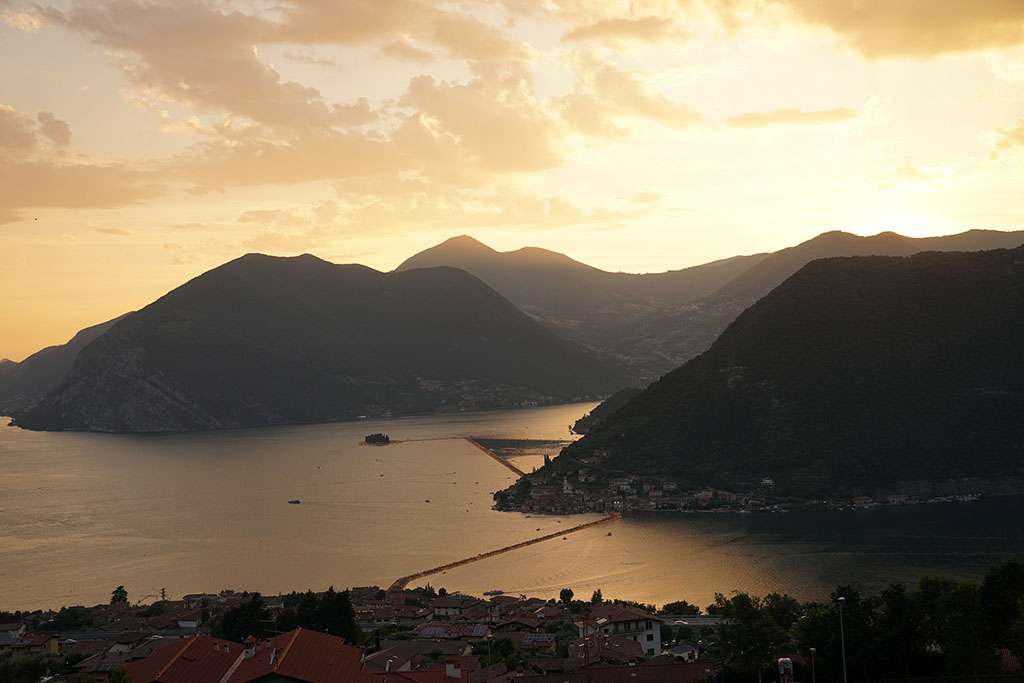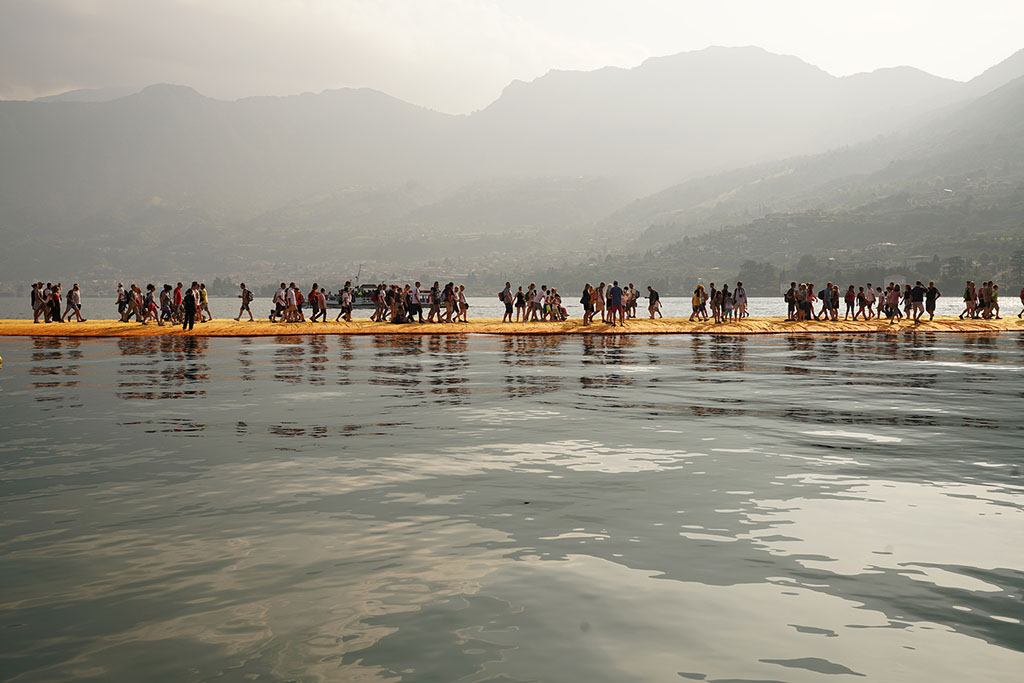walking on Water. A timeless dream that this year, for just 16 days, more than 1,200,000 people have been able to experience. The Floating Piers is the evocative title of the installation that, from 18 June to 3 July this year, has attracted international attention on Lake Iseo, in the heart of northern Italy, 100 km from Milan, where the extraordinary artist Christo (born Christo Vladimirov Javacheff) gave new emotion and an unusual perspective of the lake and the surrounding valley.
Conceived in the 70s with the art and life partner Jeanne-Claude (Jeanne-Claude Denat Marie), passed away in 2009, The Floating Piers had a long genesis until its realization in 2014 when Christo, the American artist but Bulgarian by birth, visiting lake Iseo recognized the ideal place to give shape to this project.
[one_half_last]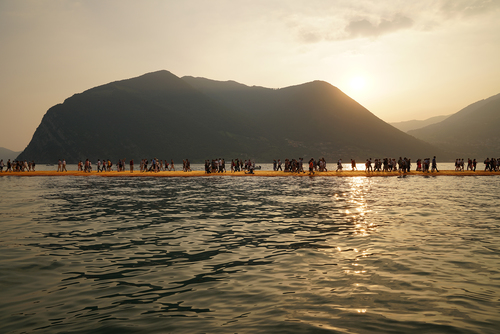 [/one_half_last]
[/one_half_last]
The work, composed of floating docks, covered with fabric, has created a footpath of 3 kilometers in length through the Lake Iseo, then continuing for another 2.5 kilometers until Sulzano and Peschiera Maraglio.
70,000 square meters of fabric in shimmering yellow cover the modular system of pontoons – 16 meters wide and 50 cm high from the sloping edges – composed of 220,000 cubic in high density polyethylene and 200 anchors weighing 5.5 tons each to maintain the width of the dock in place, developing, at water level, an installation in tune with the movement of waves.
“The Floating Piers” installation and visitors along the floating walk. (© 2016 Christo)
The artwork was an invitation, with free access, to experience a new perspective of the landscape of the lake centered around the small community of Monte Isola. An average of 72,000 people a day, from all over the world, has lived The Floating Piers and explored the city and the towns around Lake Iseo being able to enjoy the artwork from different angles.
Momentary and transient, the temporary installation is, according to Christo, one of the most important aspects of the project: an opera – and experience – to live fully in the brevity of his stay.
[one_half]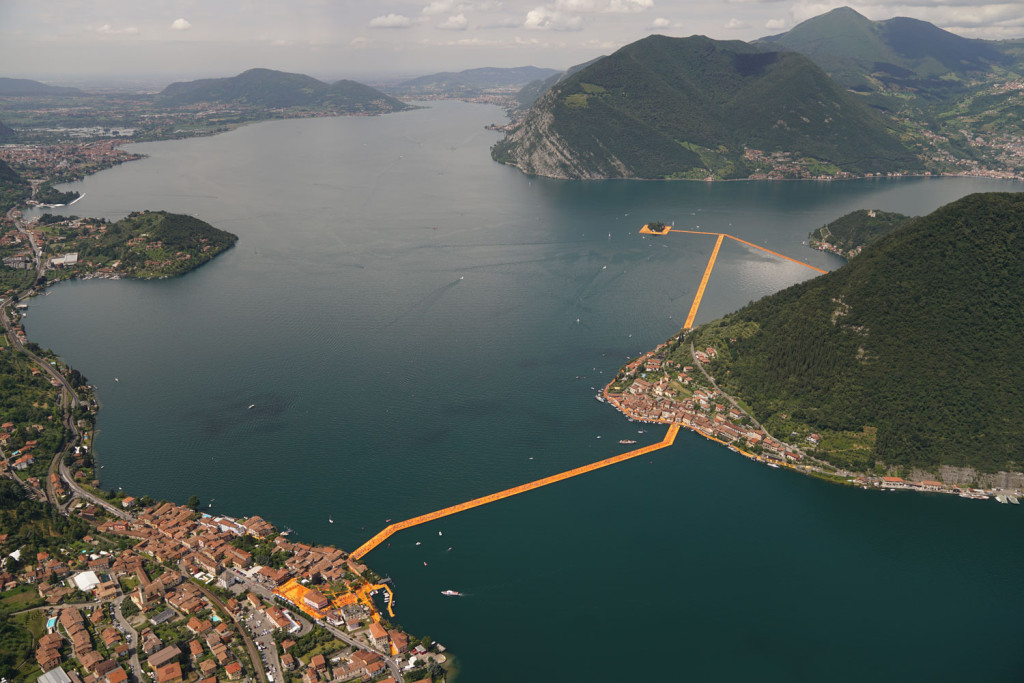 [/one_half]
[/one_half]
[one_half_last]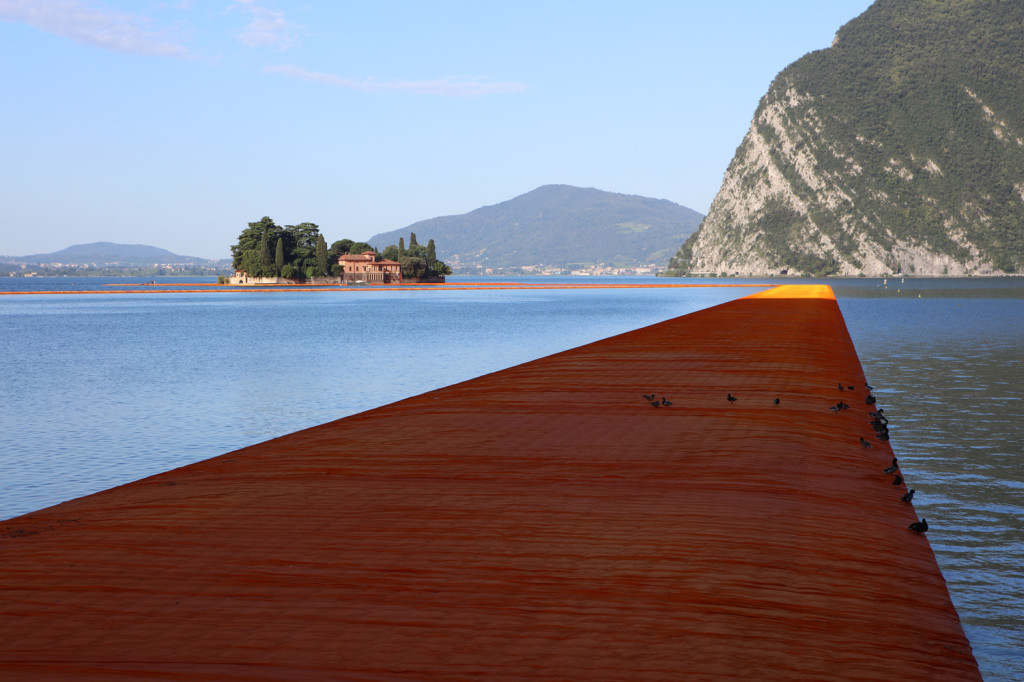 [/one_half_last]
[/one_half_last]
In the realization of the artwork, curated together with Vladimir Yavachev, Operations Manager, Wolfgang Volz, Project Manager, Josy Kraft, registrar and curator, and the Project Director Germano Celant, the artist has followed his personal ethics that always involves the collaboration of people (1,000) regularly paid and the total self-financing. The Floating Piers has cost around 18 million euro including installation, maintenance, monitoring and removal of the artwork, as well as the support for the local authorities and the host municipalities of the Region of Lombardy.
The materials used were entirely recycled industrially, through different processing methods, for use in various fields, being the preservation of the lake and its environment a top priority for the artist.
[one_half]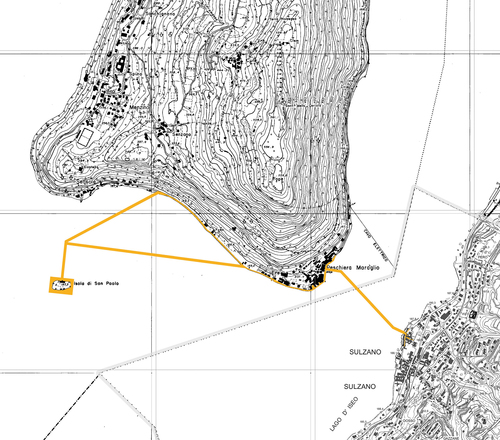 [/one_half]
[/one_half]
[one_half_last]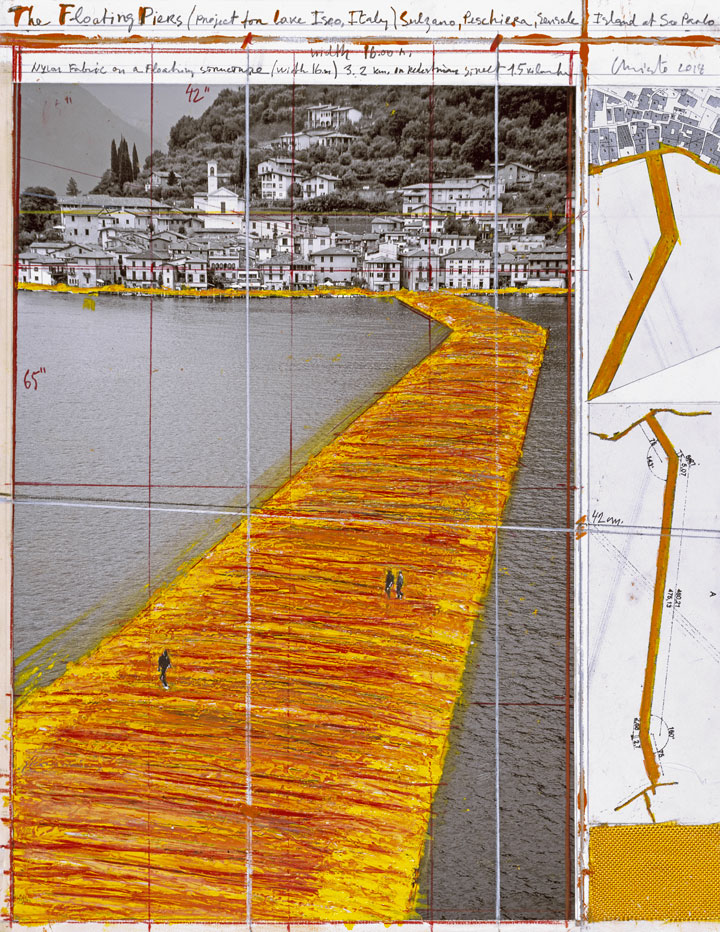 [/one_half_last]
[/one_half_last]
The number of visitors and investments brought by The Floating Piers have benefited the local economy and allow for greater social and tourism development in the years to come.
Throughout their long artistic experience, Christo (1935) and Jeanne-Claude (1935-2009) have created together some of the most spectacular works of the XXth and XXIst century. All their projects are due to go through authorization procedures lasting several decades before being implemented.
From early wrapped objects to monumental outdoor projects such as Valley Curtain in Colorado (1970-72), Running Fence in California (1972-76), Surrounded Islands in Miami (1980-83), The Pont Neuf Wrapped in Paris (1975-85), The Umbrellas in Japan and California (1984-91), Wrapped Reichstag in Berlin (1972-95) or The Gates in New York’s Central Park (1979-2005), the artists have transcended the traditional bounds of painting, sculpture and architecture. Together they changed the concept of “public art” by creating temporary works that are truly transitory by design.
[one_half]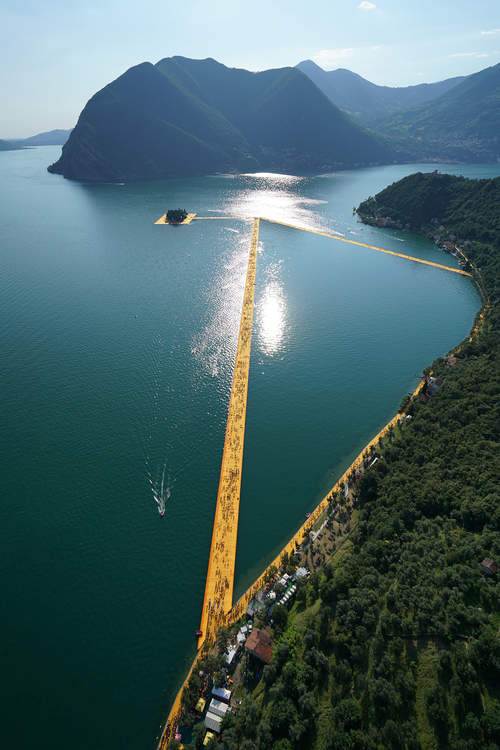 [/one_half]
[/one_half]
[one_half_last]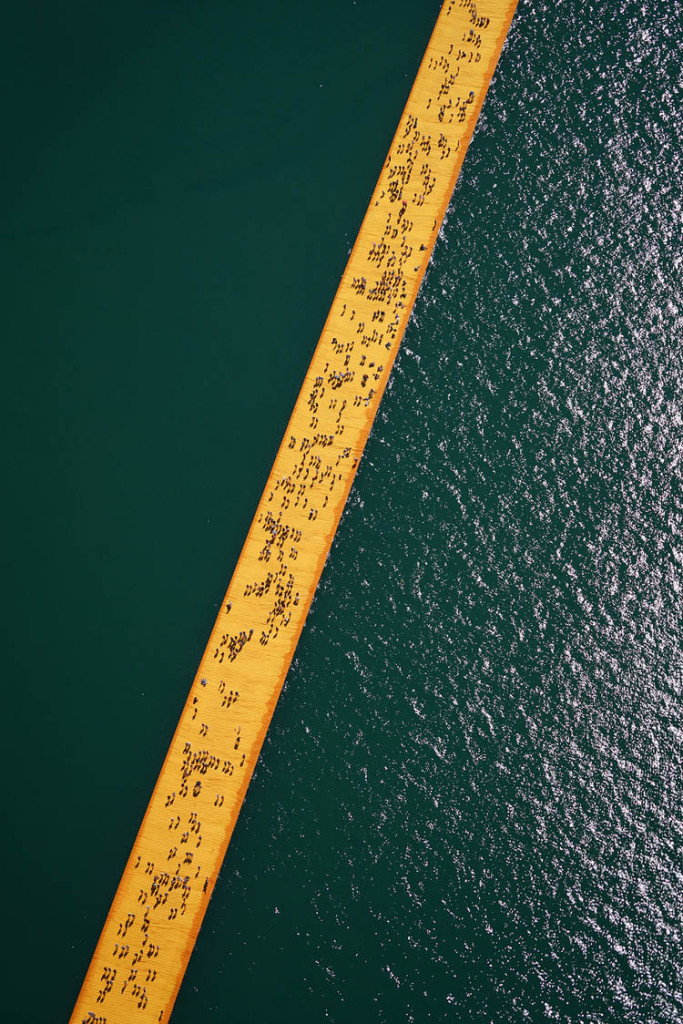 [/one_half_last]
[/one_half_last]
References
www.thefloatingpiers.com
https://christojeanneclaude.net
The Floating Pier. Una passeggiata galleggiante sul lago d’Iseo
Camminare sull’acqua. Un sogno senza tempo che quest’anno, per soli 16 giorni, oltre 1.200.000 persone hanno potuto sperimentare. The Floating Piers è il suggestivo titolo dell’installazione che, dal 18 giugno al 3 luglio 2016, ha attratto l’attenzione internazionale sul lago d’Iseo, nel cuore dell’Italia settentrionale, a 100 km da Milano, dove la straordinaria opera dell’artista Christo (all’anagrafe Christo Vladimirov Javacheff) ha regalato un’emozione nuova e una prospettiva inusitata del lago e della valle circostante. Nato da un’idea maturata negli anni ’70 insieme alla compagna d’arte e di vita Jeanne-Claude (Jeanne-Claude Marie Denat), mancata nel 2009, The Floating Piers ha avuto una genesi lunga sino alla sua concretizzazione quando Christo nel 2014, l’artista americano ma bulgaro di nascita, visitando il lago d’Iseo ne riconobbe il luogo ideale per dare forma a questo progetto.
Vedute del lago d’Iseo con l’installazione “The Floating Piers”. (© 2016 Christo)
L’opera, composta da pontili galleggianti, ricoperti di tessuto, ha creato un percorso pedonale di 3 kilometri di lunghezza attraverso il Lago di Iseo, proseguendo poi per altri 2.5 chilometri sino a Sulzano e Peschiera Maraglio.
70.000 metri quadri di tessuto in feltro giallo cangiante hanno ricoperto il sistema modulare di pontili, larghi 16 metri e alti 50 centimetri dai bordi degradanti, composti da 220.000 cubi in polietilene ad alta densità e 200 ancore del peso di 5,5 tonnellate l’una per mantenere la larghezza del pontile in posizione, sviluppando a pelo d’acqua un’installazione in sintonia con il movimento delle onde.
L’installazione “The Floating Piers” e i visitatori lungo la passeggiata galleggiante. (© 2016 Christo)
L’opera ha rappresentato un invito, con accesso libero e gratuito, a sperimentare un nuovo punto di vista del paesaggio del lago avendo come fulcro la piccola comunità di Monte Isola. Una media di 72.000 persone al giorno, provenienti da tutto il mondo, ha vissuto The Floating Piers ed esplorato le cittadine e i comuni attorno al Lago d’Iseo potendo cogliere l’opera da angolazioni diverse.
Momentanea e transitoria, la temporaneità dell’installazione rappresenta, secondo Christo, uno degli aspetti più importanti del progetto: un’opera – e un’esperienza – da vivere a pieno nella brevità della sua permanenza.
Veduta area del lago d’Iseo e l’installazione “The Floating Piers” a pelo d’acqua con Monte Isola. (© 2016 Christo)
Nella realizzazione dell’opera, curata insieme a Vladimir Yavachev, Operations Manager, Wolfgang Volz, Project Manager, Josy Kraft, registra e curatore, e al Project Director Germano Celant, l’artista ha seguito la sua personale etica che prevede sempre la collaborazione di persone (oltre 1.000) regolarmente retribuite e il totale autofinanziamento. The Floating Piers è costato all’incirca 18 milioni di euro tra installazione, manutenzione, sorveglianza e rimozione dell’opera d’arte, oltre al supporto per le Autorità locali e i comuni ospitanti della Regione Lombardia.
I materiali utilizzati sono stati del tutto riciclati industrialmente, attraverso metodi di trasformazione e lavorazione diversi, per essere impiegati in vari ambiti, essendo la conservazione del lago e del suo contesto ambientale una priorità assoluta per l’artista.
Disegni progettuali. (© 2016 Christo)
L’affluenza di visitatori e gli investimenti portati da The Floating Piers hanno giovato all’economia locale e consentiranno un maggiore sviluppo sociale e turistico negli anni a venire.
Nel corso della loro lunga esperienza artistica, Christo (1935) e Jeanne-Claude (1935-2009) hanno creato insieme alcune delle opere più spettacolari del XX e del XXI secolo. Tutti i loro progetti sono dovuti passare attraverso procedure autorizzative lunghe alcuni decenni prima di essere realizzati.
Dai primi oggetti impacchettati ai progetti monumentali all’aperto, tra cui Valley Curtainin Colorado (1970-1972), Running Fence in California (1972-1976), Surrounded Islands a Miami (1980-1983), The Pont Neuf Wrapped a Parigi (1975-1985), The Umbrellas in Giappone e in California (1984-1991), Wrapped Reichstag a Berlino (1972-1995) e The Gates a Central Park, New York (1979-2005), gli artisti hanno superato i limiti tradizionali della pittura, della scultura e dell’architettura, cambiando al contempo il concetto stesso di “arte pubblica” e creando opere temporanee dalla durata volutamente effimera.
Vedute aeree della passeggiata galleggiante sul Lago d’Iseo. (© 2016 Christo)
